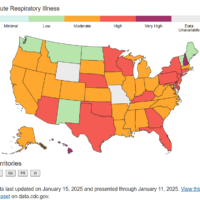For more than a year, people have pondered when the coronavirus pandemic would be over.
A firm answer to that question depends on many factors, but several key metrics used to measure the pandemic suggest that it could be time to have that conversation, Joel Achenbach writes for The Washington Post.
New coronavirus infections in the United States have dropped to their lowest rate since mid-September, and if trends continue, they will soon be lower than in nearly 11 months, Achenbach notes.

Also, nearly half of adults have had at least one dose of a coronavirus vaccine that has proven remarkably effective at preventing severe illness and death. In a separate Post article, Paige Winfield Cunningham reports positive trends in three key metrics: new cases, hospitalizations and deaths.
On Monday, May 17, Cunningham reported that average daily deaths in the U.S. had fallen 16.5% in the previous week, and are now below 580 per day; average daily hospitalizations fell 12.6%; and average daily cases fell 19.2%, with fewer than 35,000 new cases being diagnosed each day.
In Kentucky during the same week, the 7-day average of hospitalizations fell 3.5% and the weekly average of new cases dropped 12%. Death reporting in Kentucky can be slow due to delays at local health departments; the reported-death average in the state rose slightly last week.
Centers for Disease Control and Prevention models show that cases are likely to decline sharply in July.
- SUBSCRIBE: Sign up for Hoptown Chronicle’s newsletters
“We are doing extremely well in the U.S. and are well on our way of moving past the pandemic,” Monica Gandhi, professor of medicine at the University of California at San Francisco, told Cunningham.
That said, some experts say the metrics are still too high and that it is too early to declare victory. They include CDC Director Rochelle Walensky, who told a congressional subcommittee Thursday that the nation has made “extraordinary progress” but the virus has “sent us too many curveballs” to say the pandemic is over or will soon be over. “Today, I’m cautiously optimistic,” she said.
Carlos Del Rio, a professor of medicine at Emory University, told the Post’s Cunningham that his goal is to see new cases drop below 20,000 per day and daily deaths fall under 100. He said it is concerning that daily vaccinations are sloping downward.
In the last week, vaccinations in Kentucky numbered 27% less than the previous seven days. Cunningham reports that last week, the U.S. saw an 11% decrease in the number of vaccine doses administered, compared to the week before.
Experts often say we are in a race between the vaccines and the variants — mutations of the virus that are more contagious or more deadly.
That means “pandemics start quickly and end slowly,” Achenbach writes. He notes that infectious-disease experts have been clear that the virus is unlikely to be eradicated and that some measures to fight it, like booster vaccines and wearing masks in the winter, could remain part of our lives.
“COVID-19 as a pandemic will end,” Dr. Anthony Fauci, director of the National Institute of Allergy and Infectious Diseases, told Achenbach. “But it won’t end uniformly throughout the world for obvious reasons, because many countries will not have capabilities to make it end. But as a pandemic, or as a countrywide epidemic, it absolutely will end in this country.”
Fauci added that achieving this will depend on getting at least 70% of adults vaccinated and if this happens by the fall, he said, “I think we’re going to get out of the epidemic stage and much more into the control stage.”
Achenbach wraps up his article by noting five “caveats that cloud this sunny outlook:” polling that shows a significant number of people don’t want a vaccine; the possibility that mutations could erode vaccine efficacy; experts anticipate a fifth wave of the virus this winter; the U.S. is not truly safe from the virus until the whole planet is; and it is still not known exactly how many people need to have been vaccinated or have had the disease to create herd immunity, which creates significant protection for those who are unwilling or unable to get vaccinated.
Helen Branswell of Stat takes another approach to this topic, exploring how some scientists look to the past to see the future when they consider how this pandemic will end.
“The truth of the matter is that pandemics always end. And to date vaccines have never played a significant role in ending them,” she writes, adding, “That doesn’t mean vaccines aren’t playing a critical role this time. Far fewer people will die from COVID-19 because of them.”
She reports that past pandemics didn’t end because the viruses went away, but because their viruses underwent a transition, and became endemic, or common. And the big, unanswerable question when it comes to this coronavirus is, “When will that happen?”
Melissa Patrick is a reporter for Kentucky Health News, an independent news service of the Institute for Rural Journalism and Community Issues, based in the School of Journalism and Media at the University of Kentucky, with support from the Foundation for a Healthy Kentucky. She has received several competitive fellowships, including the 2016-17 Nursing and Health Care Workforce Media Fellow of the Center for Health, Media & Policy, which allowed her to focus on and write about nursing workforce issues in Kentucky; and the year-long Association of Health Care Journalists 2017-18 Regional Health Journalism Program fellowship. She is a former registered nurse and holds degrees in journalism and community leadership and development from UK.






